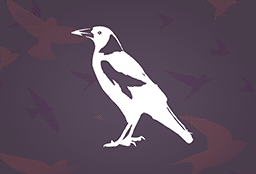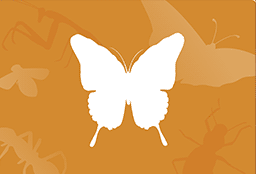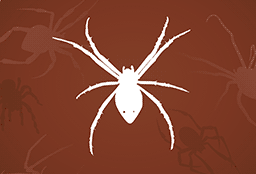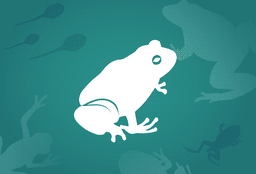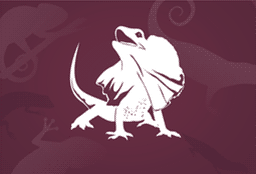Black and white, with the pattern varying across its range. The back of its neck, upper tail and shoulders (on its wings) are white in males and grey in females, and (across most of Australia) the rest of its body is black. In south-eastern, central and south-western Australia, including Tasmania, its back and rump are entirely white. Its eye is red-brown. Young birds are usually grey rather than black and have dark eyes.
Distinctive feature
One toe faces backwards and three face forwards. It has a square-tipped tail.
Also known as Blueberry Lily, a long, feathery shrub with flowers sticking up above the leaves.
Long green pointy leaves with vibrant blue to purple inflorescences (flower clusters). Grows up to 1.5 m high.
Leaves
Long, feathery, smooth green leaves. 15 - 85 cm long with 4 - 15 mm width. Pointy ends and long and stiff throughout. Can sometimes appear red towards base but this is rare.
Flowers
Flowers stick up above the leaves, consisting of 6 purple petals (7 - 12 mm length) and 6 stamens (pollen-bearing part of the flower) in a ring. These are long, thick and have brown to black tips with yellow stems.
The caterpillar (larva) is initially pale yellow with fine hairs, before turning green. It has narrow yellow lines on its body which are sometimes hard to see. The upper side of the butterfly (adult) is white with a black tip on its forewing (front wing) and a black patch on the front edge of its hindwing. A male has one black spot on its forewing, while a female has two black spots. Looking from underneath, the forewing is white with two black spots and the hindwing is yellow.
Size
Caterpillar about 3.5 cm; Butterfly up to 5 cm wingspan.
The Channel-billed Cuckoo is grey all over, with dark scalloping on its back and wing-coverts, a whitish belly and abdomen, and fine dark barring on the lower underbody. Its long tail is pale-grey on top with two central feathers tipped with white, with a black band near the tip; the undertail has black-and-white barring. In flight, its tail and wings give it a cross-shaped silhouette. Its eyes are bright red and there is a bare patch of red skin around the eye and near the base of the bill. Its legs and feet are dark grey.
Young birds are mottled buff, brown and grey, have an olive to brown eye and lack the red-colouring around its eye.
Distinctive feature
Its large, downward-curved beak which is greyish with a paler tip.
Shrub or small pyramidal tree, yellowish green or bronzy. Commonly 8 - 10 m high.
Numerous branchlets are hairy and flaky at first then become smooth and straight.The swollen orange to red stalk preceding the small hard fruit is often mistaken as the fruit itself.
Leaves
Scale-like, triangular, 0.5 mm long and 2 – 3 mm long on new growth.
Flowers
Yellow-green flowers in short, dense, clusters that are usually 6 mm long. Flowers appear in early spring to autumn (September to May).
The Christmas Spider is known by several other names, most commonly Jewel Spider but also as Six Spined Spider or Spiny Spider.
Females have bright yellow and white patterns with a ring of black spines. Melanic females have the same shape but may be completely black. Males have smaller spines and have a yellow, brown, white and black pattern. Six spines protrude from the sides and bottom end of the abdomen.
Size
Females are larger at 7 mm, males are 4 mm.
The adult male is black with a deep-orange to yellow beak, a narrow orange to yellow ring around its eye, and dark legs. The female is grey-brown, with some streaks or mottling, and its back is darker than its belly. The female also has a paler chin than the male, a dull yellow-brown beak, dark legs, and the ring around her eye is less bright. Young birds are also brown but with lighter underparts and a dark grey or black beak.
Size
25 to 28 cm (from head to tail)
The caterpillar (larva) is initially a pale yellow-grey, before turning green with long black hairs along its body. Its head is brown-black with short hairs. The female butterfly (adult) is orange with creamy yellow and dark brown patches towards the tip of its forewings (front wings). The male is less colourful, being brown and orange with no pale patches. It also has an obvious raised vein in the middle of its forewing. Both males and females have a small eye-spot on each wing. The undersides of the wings in both the male and female are paler with faint markings, and their hindwings have very few markings. The female’s hindwing is darker then its forewing. It is difficult to identify these butterflies when they are resting with their wings closed. The males emerge quite a while earlier in the year before the females.
Size
Caterpillar about 3.5 cm long; Butterfly wingspan 5.5 – 7.5 cm (females are larger than males).
Black and white, with the pattern varying across its range. The back of its neck, upper tail and shoulders (on its wings) are white in males and grey in females, and (across most of Australia) the rest of its body is black. In south-eastern, central and south-western Australia, including Tasmania, its back and rump are entirely white. Its eye is red-brown. Young birds are usually grey rather than black and have dark eyes.
Distinctive feature
One toe faces backwards and three face forwards. It has a square-tipped tail.
This frog goes by several common names: Eastern Banjo Frog, Eastern Pobblebonk Frog and Southern Bullfrog. The first two are based on its distinctive 'bonk' call which sounds similar to the string of a banjo being plucked.
Its back ranges from grey, to olive-green, dark brown or black, with dark marbling or flecks. It has a pale yellow stripe running from under its eye to its arm, a dark band above this, and may also have a pale stripe running down its back. Its sides commonly have a purple or bronze sheen, mottled with black. Its belly is white and sometimes mottled with grey. Its back is warty and rough but its belly is smooth.
Distinctive feature
A prominent gland on the outer side of its hind leg (its shin) and a fleshy lump at the base of each hind foot.
The adult male is a distinctive glossy black tinged with iridescent blue and green all over, including its long tail, and it has a striking red eye. The female is glossy brown with white spots on top, and buff-cream underneath with many fine black bars running across its belly. The top of its head is black or brown with pale streaks, and its tail is brown with white bars running across it. A young bird looks like an adult female but has buff barring on its wings and generally much more buff colouring.
It has a grey back and head, and bright-yellow underparts. Southern birds have an olive-yellow rump, while birds in northern Australia have a brighter yellow rump. Its throat is off-white and when seen in flight, it has a pale bar on its wings. Its bill is black. Young birds are rufous-brown with paler streaks.
Size
13 – 17 cm long, the males are slightly larger
Bright yellow and black bands across its abdomen, with a pair of black spots and a black triangle on each yellow band. It has yellow legs, black antennae and two pairs of transparent wings. Nests are commonly built underground with only their small entrance holes visible, which are about 2 - 3 cm across.
Size
1.2 – 1.5 cm long (worker); 2 cm long (queen)
A beetle with a shiny black back and head with bright yellow-green markings, and dark brown to black legs.
Distinctive feature
Violin-shaped markings on its back (after which it is named).
Size
About 2 cm
An adult male has a bright orange breast and throat, with white on its lower belly and under its tail. The upperparts are dark slate grey and there is a clear white stripe on its folded wing. It has a black beak and dark brown legs. A female is mostly grey-brown with a pale buff strip on its wing. Its outermost tail feather is mostly white. A young bird looks like an adult female, but its back has buff streaks and its belly is pale with brown streaks.
Size
12 - 14 cm
Grey-brown to bronze, with a dark stripe running along each side of its body from its nostril, across its eye to its tail, getting wider from its front legs. Its body pales below the stripe to a cream belly.
This species has a ‘heavier’ looking body and a more obvious stripe running along its sides, compared to the Northern Garden Skink.
Size
8 - 10 cm (nose to end of tail).
The adult male has a bright-yellow underbody, olive-green back and wings, and a black head with a bright-yellow collar. Its throat is white, with a broad black band which separates it from the yellow breast. Its beak and legs are black. The adult female has grey upperparts with a pale olive tinge, and is pale grey below with a pale yellowish tinge. Its beak is dark brown and its legs are grey-brown. Both sexes have a red-brown eye. Juvenile birds are rufous above and below, and as they mature, gradually resemble a female, though they retain some rufous feathers in their wings.
Also known as Gum-topped Box. Tree to 25 m high.
Bark is rough on part or all of trunk, thin, box-type or tessellated (mosaic-like), grey or mottled with grey and white patches; smooth bark white, cream or pale-grey, often shiny.
Leaves
Adult leaves alternate, broadly lance-shaped, 7 - 17 cm long, 2 - 5 cm wide, green, glossy, concolorous (both sides of the leaf blade are the same colour).
Flowers
White and usually clustered in groups of 7. Sometimes there are more than 7 or there may appear to be less as flowers have dropped off. They occur in multiple groups at the end of small branches.
Flower buds are ovate (egg-shaped) to fusiform (spindle shaped; tapering at both ends), 5 - 9 m long, 3 - 4 mm diameter; scar absent.
Its head and upperparts are mostly dark grey, with a white eyebrow and throat, a narrow grey band across the upper breast and a creamy-buff belly. The feathers of its long tail have white edges and tips, and the tail is often fanned out.
Size
14 – 16 cm long
Leaf Beetles are also known as Pittosporum Beetles or Bursaria Beetles, after their host species.
The beetles have a bright red head and pronotum with an entirely blue or green body. The larvae have a brown head with six distinct black eye spots on each side. Pale underside, dark upperside with dark spines.
They are aposemtatic, meaning they are posionous to visual predators. Be very careful if handling them.
Size
0.6 - 1.4 cm long; body narrow and flat. Length to width ratio ranges from 2:1 to 2.5:1. Length to height ratio is 3.5:1.
Predominantly pale tawny-orange with a heavy black border that encloses large white spots in the forewing. The inner leading edge of the forewing is deep red-brown. The underside is similar to the upper side but paler with narrower black margins. Males have a distinct patch of dark grey sex-scales on the upper side of the hindwing.
The caterpillars have three pairs of tentacles and yellow, white and black rings.
Size
7 - 8 cm wingspan.
A black and white bird, the pattern varies slightly between sexes. The male has a white eyebrow above a black horizontal eye-stripe, a black face and throat, while the female has a white face and throat, with a broad vertical stripe through the eye, and no white eyebrow. Both sexes have a thin white bill and black legs and feet. Juvenile Magpie-larks have a black forehead, white eyebrow and a white throat.
The top of its head and its hindneck are black. Its forehead is covered with bright-yellow skin, which hangs down to form wattles. The rest of the head is white. Its back and wings are pale grey-brown. Below, black plumage extends from the hindneck onto the sides of its breast, and the rest of the underparts are white. Its long legs and feet are reddish and its bill is yellow. It has a prominent spur on each wing.
Juveniles are similar to adults, but have dark ‘scallop’ markings on the back and wings, and the wing spur and wattles are either smaller or absent.
Distinctive feature
A yellow wattle that extends from its forehead to behind its eye and hangs down beside its chin.

